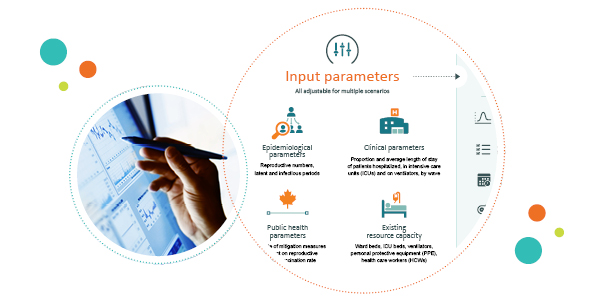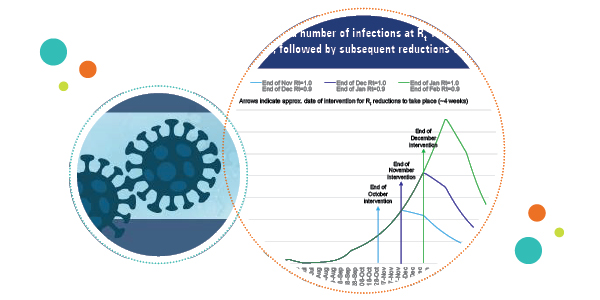Curbing the spread of COVID-19 infections
Back to Case studies: Working together to make an impact in health care
How CIHI’s Health System Capacity Planning Tool enabled Toronto Public Health to recommend timely, data-driven public health measures


Toronto Public Health used CIHI’s Health System Capacity Planning Tool to forecast the trajectory of COVID-19 infections.
Customer
Toronto Public Health
CIHI product
Health System Capacity Planning Tool
Background
In the fall of 2020, COVID-19 infections were rapidly increasing in Ontario, hospital beds were filling up and concerns were mounting about the capacity to accommodate all patients who needed hospitalization.
Recognizing the need for fast and accurate information, CIHI built on previous work and experience in forecasting demand for health system capacity and developed the interactive Excel-based Health System Capacity Planning Tool. The tool was designed to allow decision-makers to create their own scenarios to understand expected health resource demands and supply shortfalls related to the COVID-19 pandemic.
The challenge
Toronto Public Health (TPH) needed to understand the trajectory of COVID-19 infections and severe illnesses in various transmission scenarios. This was required to support the recommended public health measures needed to limit contacts in order to reduce viral transmission of COVID-19.
The solution

TPH used the Health System Capacity Planning Tool to project infection trajectories in order to assess the impact of different public health intervention scenarios.
The Health System Capacity Planning Tool allowed TPH to predict the number of new daily COVID-19 cases, the associated number of projected individuals requiring treatment in critical care and non–critical care beds with or without a ventilator, and the demand for health care resources and personal protective equipment required to treat these individuals.
By adjusting the input parameters, TPH could perform sensitivity analyses by creating different scenarios of disease progression and examining the impact on expected resource demands.

The modelling was used as an opportunity to support decision-making and to highlight to the public, as well as the provincial government, the impact of following public health measures that limit contacts to reduce viral transmission.
The impact
TPH’s Medical Officer of Health used the results produced by the tool at a public briefing on October 7, 2020, to inform Toronto residents of the potential pandemic upsurge and outlined the projected impact of implementing additional public health measures needed to curb the spread of COVID-19. In addition, TPH’s Medical Officer of Health wrote a letter to Ontario’s Chief Medical Officer of Health requesting that a series of new restrictions be implemented before the Thanksgiving long weekend, when people are known to gather and increased contact is likely. These measures included prohibiting indoor dining and asking residents to leave their homes for essential reasons only.
On October 9, 2020, the Ontario government announced that it would implement targeted public health measures in Toronto, Ottawa and Peel, such as prohibiting indoor dining, closing gyms and imposing limits on social gatherings.
“The health experts presented the most recent health data, which identified some alarming public health trends that require immediate attention and early action to keep people safe,” said Premier Doug Ford. “That’s why we are making the difficult but necessary decision to accept the health advice, and impose further restrictions in Toronto, Ottawa and Peel Region.”
Over 75 other organizations across all provinces and territories — including federal and provincial public health agencies and health ministries, public health units, academics and hospitals — used the tool to help with their health system capacity planning for COVID-19 patients. The tool has been used for updates to executive teams and government officials, for validation of projections produced by other models, and for inclusion in local dashboards for operational planning.
A need identified and addressed
While the Health System Capacity Planning Tool is no longer in use, its development demonstrates CIHI’s agility to remain responsive to the ever-evolving health care landscape. By working closely with key stakeholders in the industry, CIHI can address issues promptly, allocate resources to relevant analytical tools, enhancing its ability to deliver accurate and timely insights to meet current and future client needs and better support data-driven health care decision-making.
Related resources
- Health System Capacity: Measures to Support System-Level Monitoring in Canada (PDF)
- CIHI’s Health System Capacity Planning Tool [information sheet] (PDF)
- Ontario Implementing Additional Public Health Measures in Toronto, Ottawa and Peel Region [news release]
- Ontario Taking Immediate Action to Reduce Rates of Transmission in Toronto, Ottawa and Peel Region [backgrounder]
- Adaptable and interactive tool for COVID-19 healthcare planning [Hospital News article, page 62]
Contact us
Contact us at this email address:
Back to Case studies: Working together to make an impact in health care
How to cite:
Canadian Institute for Health Information. Curbing the spread of COVID-19 infections. Accessed April 25, 2025.
If you would like CIHI information in a different format, visit our Accessibility page.

